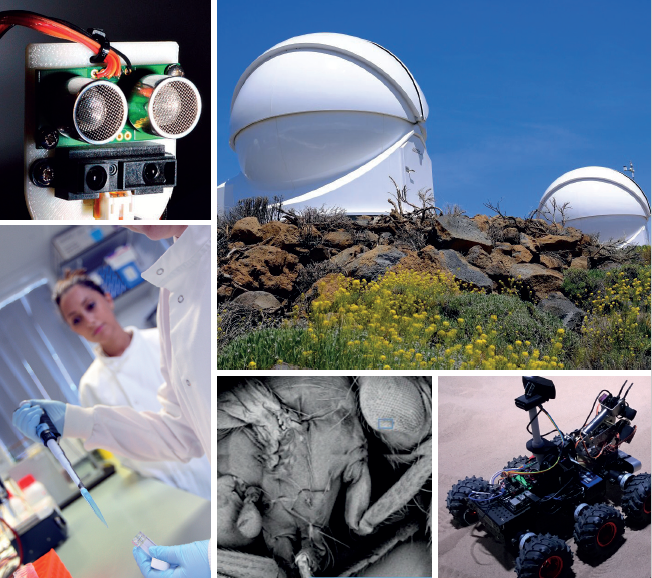About Us
Our history
The OpenSTEM Labs were created in 2015 through a capital investment grant from the then Higher Education Funding Council for England. The development project grew out of the OpenScience Laboratory (established in 2013 with funding from the Wolfson Foundation). Since then we have continued to expand into new disciplines and to grow our equipment base to provide the STEM curriculum with unprecedented access to laboratory and field investigations in a distance learning context.
Our vision
We empower STEM students to achieve their goals by developing skills and knowledge through online practical and practice-based learning activities using specialist equipment and authentic digital resources.
Our mission
The OpenSTEM Labs are a collaboration between academics, lab teams, developers and other professional services staff to create, manage and maintain online practical and practice-based learning activities for students in the STEM disciplines.

Our values
The core values of the OpenSTEM Labs are:
- Active: Engaging students in practical experiments and activities.
- Authentic: Working with data from real equipment, observations, models and publications.
- Student-centred: Tailoring activities to facilitate student learning.
- Inclusive: For students, at any time, from any place.
Our Executive Dean, Prof. Nicholas Braithwaite, explains what we do in more detail ...
Professor Nicholas Braithwaite: Hello I'm Nicholas Braithwaite, I’m the director of the OpenSTEM laboratories. Right now I’m in one of our on-campus labs with some of the apparatus around us but for The Open University with a distance teaching model we have to have some way of connecting our students with real apparatus when they're not here at a particular time, they're working remotely, let's see how we do that.
One solution we've been playing with is webcasting over the internet from a laboratory so we can get students right into the front seat around the lab bench. So, here we are in our lab casting facility we have cameras set up, we have monitors that we can see and down here we've got the apparatus that we're going to be talking to the students about and they can interact with this using a chat line and telling us how they feel about it but they're not going to control it for that we need other solutions.
To provide our students with some kind of hands-on element we've developed what we call the OpenSTEM Labs which is a virtual building on a campus not a real one and that comprises an OpenScience Laboratory OpenScience Observatories and an OpenEngineering Laboratory and here are students around the outside sending control signals for the instruments and receiving data back and possibly exchanging information between themselves and working collaboratively around this building in the virtual world.
This is the open engineering lab and you can see in the background some of the pendulums that are being controlled by our students unlike a normal lab this is laid out using all the three-dimensional space we don't have to put it out just in two dimensions and leave room for the students and to show you how versatile this is and how students can reach it from anywhere over to my colleague Tim Drysdale.
Dr Tim Drysdale: So, this might seem like a frivolous example but I’m going to connect to our remote lab from outdoors. Now the point of this is to show you that you can connect to our remote lab from anywhere you can get a wi-fi or internet connection. So it's as simple as going to the web link I’ve got the address ready here press the enter key and then hey presto that's the pendulum experiment that we want to do it's up on the screen and now I can start the experiment I can move some knobs that's the pendulum moving and we're often racing.
Professor Nicholas Braithwaite: We can connect students to sophisticated instruments and specimens to look at for example live worms in an optical microscope or dead flies in an electron microscope.
Dr Nicola McIntyre: When planning external engagement and outreach events here in Ireland selecting appropriate resources which demonstrate what is unique about science teaching at the OU has always been a challenge. Remote access to the scanning electoral microscope has solved that problem. We have used it at an event instalment in an OpenSTEM lab workshop for school teachers and also at an OU open day. The scanning electron microscope with its range of samples always has a big impact and helps drive home the point that we can deliver practical science for our distance learning students.
Professor Nicholas Braithwaite: And distance is no barrier for the OpenSTEM labs we can even allow students to study geology on Mars.
Dr Susanne Schwenzer: My research is actually on Mars and in that capacity I work on the Mars curiosity mission with NASA. That means I know a lot about Mars missions I also took part in ESA and other Mars mission simulations where scientists and engineers are being trained to actually do Mars missions and we brought exactly that to the OU using hardware such as you can see here and the landscape around me. We also use a real interface that looks actually very similar to what is being used by space agencies worldwide to operate their own missions. We bring students together from all over the world to work on a mission to explore the rocks to find out what we have and feel like they were on Mars with it.
Professor Nicholas Braithwaite: And for studying at even greater distances we have remote access to professional grade telescopes.
Dean Roberts: I use the Open University's robotic telescopes in Tenerife to do my research with and here I’ve got the dashboard that we use to interface with telescopes and this is also what the students see when they are forming their online courses. I also help out with our undergraduate students while they're doing their online courses using the PIRATE and COAST robotic telescopes this is similar to what demonstrators would do at undergraduate level in other universities where they go into labs and help out with the work in the physical laboratory. My research involves using the PIRATE robotic telescope that we have in Tenerife to perform rapid follow-up of the LIGO gravitational wave alerts, to hopefully look for some transients that are associated with these gravitational waves. That could be anything from neutron star binaries to black hole binaries that produce an electromagnetic signal in the sky that we hope to follow up with these telescopes
Professor Nicholas Braithwaite: The open stem labs aim to allow students to access real equipment and to operate it as if they were right there with it.
Kimon Papathanasopoulos: it is a very nice experience because I can feel that it’s preparing us in our you know future possible science career. As a scientist nowadays they work remotely, also it is impossible very often to travel to other science institutes to do their work, so they need to have the remote experience. So, yes for me it was good, it was excellent.
Professor Nicholas Braithwaite: Distance is no barrier to us as we connect our students wherever they are to benchtop experiments, microscopes, telescopes, robots, rovers and even a satellite.
Our assets
Our list of experiments grows all the time as we add new equipment and activities to enabel further STEM disciplines to be explored. Here is just a taster of current assets....
- 100 electronics workstations
- 7 analytical chemistry tools
- 2 state-of-the-art scanning electron microscopes
- 2 optical microscopes
- 2 research grade optical telescopes
- 1 enclosed 'Mars landscape' and remote controlled, multi-user Mars rover
- Digitally enabled labs for live streaming of experiments
- 5 wind tunnels
- 8 thick-walled pressure vessels
- Ideal gas experiment
- Over 50 interactive screen experiments using real data and authentic interfaces
- 2 digital particle cameras allowing real-time display of ionizing radiation.
All accessed over the internet through a web browser, a user has no need for specialist software or equipment.
A complementary set of on-screen experiments link archival data to virtual instruments with varying degrees of virtual or augmented reality.
Visit the OpenSTEM Labs
Our OpenSTEM Labs are available to license, offering an authentic lab experience that is perfect for distance learning. Visit our Education Partnerships website to find out more.
Get in touch
Email: openstemlabs@open.ac.uk
Meet our Academics

In addition to teaching on Open University modules our academics are engaged in ground breaking research that benefits individuals and society.
Request your prospectus
Explore our qualifications and courses by requesting one of our prospectuses today.
Request prospectusAre you already an OU student?
Upcoming Events
STEM Freshers': OpenTalk- Visions Matter
Thursday, September 18, 2025 - 19:00 to 20:00
Online & Berrill Lecture Theatre, Walton Hall
STEM Freshers': Welcome to the School of Environment, Earth and Ecosystems Sciences
Wednesday, October 1, 2025 - 19:00 to 20:00
Teams Webinar
